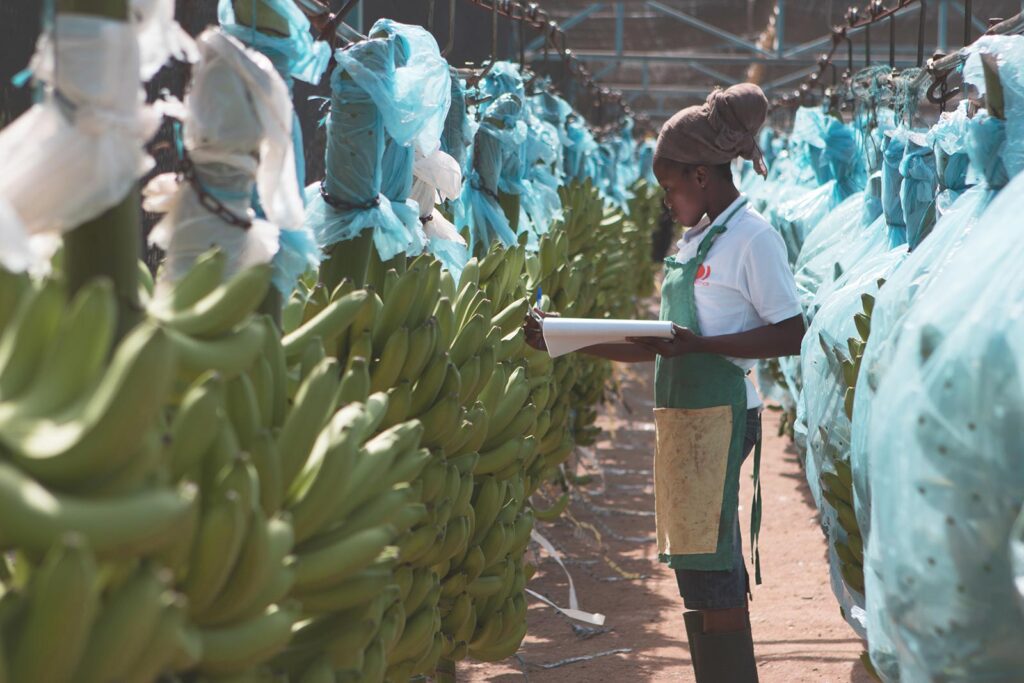La banane est un fruit fragile exigeant de nombreux soins et contrôles, depuis sa floraison jusqu’à sa consommation. Parcours et vie d’un fruit raffiné.
Chaque jour en Afrique et en Amérique latine, des mains expertes cultivent des bananiers, plantes éphémères néanmoins productives. Récoltées toute l’année, les bananes sont des fruits pérennes à croissance rapide (environ 9 mois). S’il en existe aujourd’hui plus de 1000 variétés, la banane dessert Cavendish compte pour plus de la moitié de la production mondiale. Moelleuse, sucrée, immaculée et choyée, une Cavendish peut rencontrer plus d’une cinquantaine d’intervenants avant d’atterrir dans nos assiettes.
Culture et récolte : des gestes précis
Cinq mois après la plantation des boutures ou rejets, la floraison se déclenche sur un tronc essentiellement constitué de feuilles enroulées. Apparaît ensuite le régime de bananes composé de « mains », les bouquets, et de « doigts », les fruits. Sensibles au froid, au vent, aux variations de températures, aux moisissures, aux insectes et aux chocs, les bananes requièrent beaucoup de douceur et de soins. Dans les plantations où le sol est régulièrement drainé, les cultivateurs s’affairent. Ils effeuillent, mesurent, fertilisent, éliminent les pistils et parasites, pratiquent le tuteurage, tout en surveillant les coulures de latex et traquant les parasites ou champignons. Ils n’oublient pas non plus de supprimer les rejets qui se forment au pied de la souche mère menaçant la survie du bananier, c’est l’œilletonnage. D’ailleurs, au moment de la récolte, un seul rejet successeur sera sauvegardé. Vers le sixième mois, ils protègent les régimes à l’aide d’une gaine. Ce sac de protection permet également de créer un microclimat propice à la croissance des fruits.

Une fois que les bananes ont atteint la taille souhaitée et qu’elles entrent naturellement en phase de sommeil, les gaines sont retirées et des séparateurs sont posés entre chaque main. Cette période durant laquelle les fruits freinent leur respiration et donc leur maturation, est souvent comparée à une forme d’hibernation. C’est à ce moment-là que la récolte peut commencer. Taillés manuellement d’un geste net, les régimes qui produisent jusqu’à 250 bananes sont portés à l’épaule et délicatement déposés dans des bacs suspendus à des câbles parcourant la plantation. Arrivés à la station de conditionnement, ils sont ensuite découpés en bouquets, trempés et frottés dans un bain de sulfate d’alun, afin d’éliminer tout résidu de latex ou insecte récalcitrant.
Préparées pour le grand voyage
Avant de procéder à l’emballage, des classificateurs vérifient la qualité esthétique des bananes encore vertes. Celles destinées au marché européen doivent suivre des normes strictes en termes de taille, de morphologie et de colorimétrie. Celles qui ne correspondent pas sont d’emblée écartées. Triés, pesés, étiquetés, les bouquets conformes sont ensuite disposés avec soin dans des cartons ajourés et aérés. Des agréeurs contrôlent les indications affichées sur les colis comme la catégorie, la destination finale et le code de traçabilité. Enfin, les colis sont ensuite rangés sur des palettes également munies de codes-barres. Une fois arrivées au port de départ, les palettes partent en chambres froides fermées et ventilées, où règne une température de 13 à 14°. Les bananes voyageront dans ces conditions afin que leur phase de sommeil soit prolongée le temps du trajet.
Pour exemple, les bananes produites en Afrique par la Société de Culture Bananière (SCB), une des filiales de la Compagnie Fruitière, sont chargées sur des navires à Abidjan, en Côte d’Ivoire. Le transport qui peut durer entre 10 et 15 jours importe tout autant que le sol des plantations, l’ensoleillement ou l’humidité à l’année. Dans les cales des navires, thermomètres et ventilateurs maintiennent les bananes vertes en sommeil. Une simple variation de quelques dixièmes de degré risquerait de déclencher une maturation trop rapide, ou à l’inverse de provoquer des frisures dues au froid. Une fois débarqués dans les ports européens, 3% des colis (environ 250 palettes) sont auscultés à la loupe afin de contrôler si la taille, la courbure et même le blanc de la chair correspondent bien aux normes européennes et à la catégorie indiquée. On s’assure également que les fruits ne présentent pas de couronnes endommagées ou de traces de latex.
Maturation et consommation
Avant d’être livrés aux commerçants, les fruits doivent encore reprendre leur cycle de maturation, placés en mûrisserie. En quelques jours, dans une atmosphère contrôlée à environ 17°, l’amidon se métamorphose en sucre, la peau jaunit et la chair s’attendrit. Délicieuses mais toujours fragiles, les bananes livrées aux clients doivent être extraites de leur carton avec précaution, soit un bouquet à la fois. Conservées loin du réfrigérateur, elles pourront alors garder pendant une semaine leur belle couleur ocrée et la douceur de leur goût valeureusement gagnés.